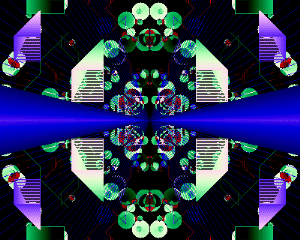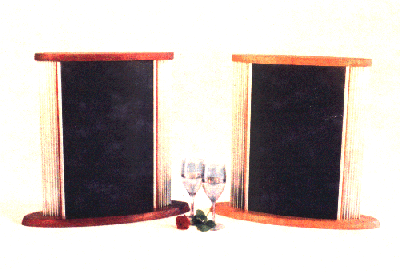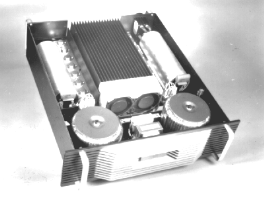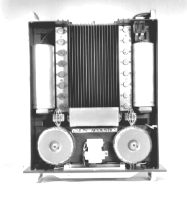 Overview
Overview Overview
Overview
Brochure of the Opus III Power Amplifier
 Overview
Overview"We've all watched the Computer Industry grow through at least five platforms of speed, size, and performance in less than two decades. However, the Audio Industry has held onto the same design standards for over fifty years; and yet we are no closer to reproducing real music that sounds like "live" than we were fifty years ago. In fact, the best sounding systems today still use 50 year old vacuum tube technology!"Aurica Sound Labs is a Research & Development Laboratory that has broken the "sound barrier" between Live Music and electronically reproduced sound.Now that we are in the next century, isn't about time we raised the performance platform in Audio Sound Quality?
In short, Aurica Sound Labs challenges all other audio equipment manufactures to match a new standard in extended audio bandwidth: from 5 hertz to 500,000 hertz, and still remain stable into all cable and speaker loads.
To save valuable development time and money in achieving
this difficult performance level, you can license Aurica's patented amplifier
technology and integrate it into your existing manufacturing line within
a few months.
For the last two decades, Aurica has been developing and testing new patented circuitry that revolutionize the way high speed audio circuitry is designed and built. All of the fundamental electronic building blocks used in Audio are now available from Aurica in new, wide bandwidth single, dual, quad, DIP, and SMT packages.
To arrange a demonstration and obtain more information on our licensing program please contact us at Aurica Sound Labs.
Hear for yourself and then determine if Aurica's Technology could put your company on the leading edge of the Audio Market.
Just as two eyes can see in three dimensions, two ears can also "see" the placement of a sound in three dimensions as well. This stereo effect takes place with a resolution that is far beyond the 20,000 Hz limit of today's audio equipment. In fact, two ears working together can resolve as little as 5 micro-seconds in phase difference. That is one cycle of 200,000 Hz, or just 5 thousands of an inch at the speed of sound. This is how subtle the phase/timing information must be for the total hearing system to accurately locate sounds in three dimensional space.
Recreating the precise timing of two audio signals in real time "stereo" to recreate the position of one sound in one position accurately is very difficult. The appropriate sounds must reach both ears within the original 5 microsecond accuracy needed for the "hearing location senses" to work properly. Aurica's OPUS III Amplifier has 70 times the resolution needed for this precise 3-D timing. The Overall Response Delay Time from input to output is .072 microseconds, or 72 billionths of a second; fast enough to place any stereo transient signal in 3-D space.
Unfortunately, the best phase accuracy of today's stereo audio is only about 50 micro-seconds, (the bandwidth of a 20 kHz sine wave); which does not come even close to our true and natural hearing abilities.
This is one of the major reasons that "audio" does not match "live music". The fact that the audio industry has not yet matched the true accuracy of the human hearing system. Knowing the human brain can process the 3-D sound space with incredible accuracy, Aurica has designed a new standard in audio equipment with these capabilities in mind.
Moreover, most music has been permanently distorted by Slew Induced Distortion, S.I.D., which is so prevalent in the Audio Industry, it's hard to get past it. S.I.D. destroys most of the musical quality and "positioning information" of the original performance, resulting in the large gap between "live" and "recorded" music.
There are No Special Effects, and No Digital Processing; --just pure, clean, unaltered, wide bandwidth signals coming through the best linear pipeline in the Analog Electronics Industry. Aurica can applied this to all power levels, from low level Microphone Pre-Amps to high power P.A. and Power Servo Amplifiers.
Your ears will truly see the difference.
Finally, a New Platform in High Resolution Audio is
available for High Definition Audio, HDTV, and Multi-Media Applications
 Tech
Brief
Tech
Brief
TECHNOLOGY DESCRIPTION
BACKGROUND
The current state-of-the-art for affordable audio equipment has hit
a ceiling. Incremental improvements in overall sound quality raises the
selling price exponentially; keeping the accurate sound systems capable
of reproducing truly realistic sound quality out of the reach of the average
user.
Today's State-of-the-Art in Audio is over 50 years old. Audio Electronics today has not advanced much in these past years. There are a few esoteric products that are fine enough, but they are so costly they are largely prohibitive to most users, ($5000 per unit and up). Throughout all consumer electronics, solid state audio equipment still has a characteristic 'cold, flat metallic' sound resulting from these odd-harmonic distortions. This type of sound can become harsh during loud musical passages and adds quickly to listener fatigue. This includes the recordings made on professional audio equipment, as well as concert PA systems. In fact, audio purists most often prefer the smoother, even-harmonic distortions of tube equipment, a technology that goes back more than 70 years.
Musicians, Recording Studio's, and sophisticated audio enthusiasts have
traditionally been the leaders in demanding higher quality audio performance.
Since the advent of stereo recordings, the requirement for a "realistic
sound stage" in the listening experience has become a dominate feature.
In order to provide a realistic spatial quality, any audio system much
match the human hearing system's natural ability to locate various sounds
in 3-D space simultaneously. This requires that the 'phasing' of both left
and right stereo channels match the physical, stereo-acoustic "image+echoes"
of the original sound -- down to a resolution of 5 microseconds.
(i.e. this 5 uSec. is the relative timing needed between the two sounds
coming from two different speakers for the mind to mentally create the
image and position of one sound.)
In addition, specific odd-harmonic distortions such as TIM & SID
Distortions must be completely eliminated from the signal path in order
to reduce the direct destruction of the original analog signal. This severe
problem is extensive throughout the Audio Industry and is largely responsible
for the "Amplifiers Do/Don't Make a Difference" Argument and the "Tube
vs. Solid State" split in audio market preferences. This TIM/SID distortion
mode is excessively common in solid state amplifiers, from microphone pre-amplifiers,
to mixing consoles, to all forms of recording and playback equipment. This
problem also exists in both Analog-to-Digital and Digital-to-Analog Converters
as well, --so going "digital" simply makes this problem worse.
In short, today's audio equipment, with its limited 20 kHz bandwidth, resolves to only about 50 microseconds, or ten times slower than is required by the "two-eared" human hearing system. In addition, Slew Rate, caused directly by solid state Op-Amps, produces large percentages of odd-harmonics while erasing subtle spatial information needed to locate the positions of instruments accurately.
AURICA has revolutionized traditional solid state amplifier design to meet the actual requirements of the human hearing system. This is unprecedented throughout the Audio Industry.
OVERALL TECHNICAL CONCEPT
There are two of the Fundamental Problems with Audio Equipment today that make it difficult to reproduce sound that matches the dynamics and ambiance of live music. The first deals with the basic misunderstanding of the true accuracy and resolution of the human hearing system. The second problem concerns the widespread use of the Op-Amp, an electronic building block that causes these TIM/SID distortions and is seriously flawed for audio reproduction.
1.) There has been a long standing misconception in audio about the real resolution of the Human Hearing System. Since the beginning, the assumption has been that 20 kHz was the highest usable frequency. This is true if only one ear is measured at a time. However, two ears working in unison have a much higher resolution. Just as two eyes can see in three dimensions, two ears can also "see" the placement of a sound in three dimensions. This 'stereo' effect takes place with a resolution that is far beyond 20 kHz. In fact, two ears can resolve as little as 5 millionths of a second in phase differences between them. (That is one cycle of 200 kHz, or 5.5 thousandths of an inch.) This timing information is used to locate both the position and the motion of sounds in 3-D space.
This psycho-acoustic phenomenon can be referred to as Auditory Vision, where one can envision the exact placement of these sounds without the use of sight. Bats have long since been known for this ability, but humans also possess this instinctive ability to an amazing degree. So much in fact, that we continuously resolve 3-5 uSec between our ears in real time. For this reason, most everyone can easily detect the difference between live sound and its recorded reproduction. Aurica can resolve the Stereo Image Field with less than 0.072 uSec's, (72 billionths of a second), of matching between channels.
AURICA is concerned with the fact that the audio industry, at large, has never really taken into account the true resolution of this human auditory system. Yet, all the time, the industry has been attempting to recreate the "stereo image" of a live performance in the home living room. In fact, both CD's and DAT tapes are limited to a resolution of about 50 uSec, (this the period of a 20 kHz sine wave, the upper frequency limit of most all audio systems and CD recordings today).
2.) Another major problem that exists throughout the audio industry is the widespread use of operational amplifiers or Op-Amp's. These analog devices can be found in just about every piece of professional and consumer audio equipment. Op-Amps have been at the heart of Audio since the advent of solid state electronics and are directly responsible for the 'cold, flat, metallic, & boxy' sound of solid state audio equipment.
Limiting bandwidth, changing harmonic content, erasing ambiance, or removing other subtleties anywhere in the audio signal chain will seriously degrade our ability to recreate mental images of live instruments emanating from two individual speakers. Unwittingly, Op-Amps and Differential Pairs have been largely responsible for these degradations throughout the history of solid state audio electronics. Even though these devices are considered to be very linear with low THD, they stall on the dynamic input signals commonly found in music. This directly causes Slew Rate, which in turn, generates odd-harmonics and obscures critical timing information needed in your brain to recreate the visual sensation of 3-dimensional, live sound.
The problem does not exist in the nature of solid state electronics; rather, it is the topology of the transistors used in solid state that is the weakness. AURICA has patented a special arrangement of transistors for a specific reason. There are significant performance advantages over most all traditional solid state designs, circuits, and ICs; --especially in audio.
The inherent problem is that all traditional Op-Amp's are built around the core architecture of the Differential Pair for an input. This structure inherently causes Input Storage Delays, Slew Rate, Ringing, and High Frequency Instability in all Op-Amp's. When applied to an audio signal, slew rate actually erases room ambiance and subtle instrument texture, and replaces this missing information with odd harmonics; resulting in that harsh, flat metallic sound. Ringing adds extra harmonics to the music and 'smears' the stereo image. And, at high frequencies, instability makes it very difficult to design wide bandwidth audio equipment without increasing development costs and extending time to market. These problems get worse as music becomes louder in the audio signal chain. Also, these problems exist in many other areas of analog drive electronics, for instance, large servo motors, or high speed digital-to-analog converters.
AURICA's solution replaces the Op-Amp across the entire electronics industry. AURICA has developed and patented new architectures in solid state transistor design that completely replaces the Op-Amp in all high speed, high power applications. This economical solution typically has fewer parts while eliminating the Differential Pair and its attendant problems of slew rate, SID/TIM, ringing, and high frequency instability. This new, wide bandwidth circuitry is easier to design with, is far more stable under an extreme range of input and loading conditions, and has a large impact on the sound quality of low cost audio equipment.
Auditory Vision is with us all, continuously, and in real time. AURICA Sound Labs is an industry leader in bringing the true-to-life accuracy of auditory vision to the electronic signal chain for the first time. AURICA Sound Labs is a Research firm dedicated to developing completely new testing standards, novel circuit architectures, and universal design rules for a new, industry-wide platform in Stereo-Acoustic Imaging Systems and 3-D, Virtual Reality Sound Systems.
AURICA's technology can be considered as a new platform in Analog Electronics, increasing both speed and precision for a wide variety of products, from audio equipment to hard disc drives, from servo control systems to robotic assemblers.
 Business
Plan Summary
Business
Plan Summary
EXECUTIVE SUMMARY
AURICA has developed a new, high resolution, OEM Platform for the Audio Industry. It is similar to HDTV in scope and is based on AURICA's patented breakthrough in solid state analog electronics which uses advanced feedback architectures. These advancements open a wide variety of opportunities across the Electronics Industry, from Servo Control and Robotics, to High Speed Instrumentation, and Data Conversion. Audio Electronics, however, shows the most tangible difference of these unique properties to the widest market base. Therefore, the Audio Industry was chosen as the best market to introduce this new analog circuitry.
THE BUSINESS OVERVIEW is a condensed Business Plan for Aurica Sound Labs detailing market strategies and long term goals. Complete finacial spreadshets are available upon request and signing of Aurica's Non-Disclosure Agreement.
 The
Opus III, an Extreme Hi-End Audio Amplifier.
The
Opus III, an Extreme Hi-End Audio Amplifier. AURICA
Sound Labs is pleased to offer a new height in listening pleasure.
For the first time in the history of audio, Aurica's Amplifier Technology has dramatically refined
the true image of the Audio Musical Sound Stage. These unique, solid state
amplifiers offer many advantages not found in either of today's conventional
solid state or tube amplifier designs. Characterized by Instantaneous
Speed & High Current Delivery, Extremely Wide Bandwidth,
Ruler-Flat
Phase Response, and Unprecedented Stability, this new breed
of amplifier will satisfy the most demanding ears on during the most demanding
passages with breathtaking depth and realism. This exhilarating experience
is quite unlike the cold, harsh, metallic, boxed-in sound of most conventional
solid state amplifiers. Suddenly, the Sound comes alive by itself as the
speakers disappear into the nuances of the music.
AURICA
Sound Labs is pleased to offer a new height in listening pleasure.
For the first time in the history of audio, Aurica's Amplifier Technology has dramatically refined
the true image of the Audio Musical Sound Stage. These unique, solid state
amplifiers offer many advantages not found in either of today's conventional
solid state or tube amplifier designs. Characterized by Instantaneous
Speed & High Current Delivery, Extremely Wide Bandwidth,
Ruler-Flat
Phase Response, and Unprecedented Stability, this new breed
of amplifier will satisfy the most demanding ears on during the most demanding
passages with breathtaking depth and realism. This exhilarating experience
is quite unlike the cold, harsh, metallic, boxed-in sound of most conventional
solid state amplifiers. Suddenly, the Sound comes alive by itself as the
speakers disappear into the nuances of the music.
Finally, There is New Life in the Enjoyment of Your Music.
SPECIFICATIONS: Value: (Conditions:) Comments:
 Additional
Products
Additional
ProductsThe following products should be available nationwide by the end of the second and third years.
Below are pictures of the XS-2000, Aurica's Professional P.A. Amplifier; It is designed for a 20 year service life and delivers as much power as one can pull out of the wall sockets without burning the place down... Caution is advised...


To obtain more information, please contact us at Aurica Sound Labs.
Original Material, All Rights and Copy Rights Reserved, Web Page by Aurica Web Labs, 4-2003.